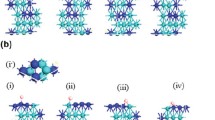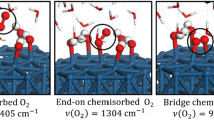Abstract
A study on the molecular adsorption of a water (H2O) monomer on Pt alloy surfaces with binary Pt-Ru and Pt-Mo and ternary Pt-Ru-Mo surface models was conducted. Some calculations of the interaction between a H2O monomer and the Pt surface were also done for reference. This study is based on density functional theory (DFT) with periodic models and aims to understand the H2O adsorption mechanism. In Pt, Pt-Ru, and Pt-Mo surfaces, H2O preferably adsorbs via an oxygen atom in a flat configuration at the top sites of Pt, Ru, Mo, respectively. However, on the ternary Pt-Ru-Mo surface, the adsorption configuration has the most inclined H2O structure relative to the surface. The results showed that the binding energy of H2O/Pt-Ru-Mo > H2O/Pt-Mo > H2O/Pt-Ru > H2O/Pt. The adsorption mechanism was then clarified by charge transfer and natural bonding. The charge transfer from the surface to the adsorbate is observed in all models, with the greatest charge transfer occurring on the surface of Pt doped with two Mo atoms. This is probably due to the fact that oxygen can attract the most charge on Mo, because the difference in electronegativity is greatest. The calculation results also show that Ru is the most hydrophilic metal for oxygen. However, since the adsorption structure is parallel to the surface, hydrogen (H) is also more sensitive to receive the charge. Subsequently, the most acceptable reason for the most stable adsorption for H2O/Pt-Ru-Mo is that the inclined structure yields the most orbitals hybridization at the H2O's highest occupied molecular orbital (HOMO). This drives the interaction by forming bonding states at the lowest energy and anti-bonding states at the highest energy.
Similar content being viewed by others
References
N. Kakati, J. Maiti, S.H. Lee, S.H. Jee, B. Viswanathan, and Y.S. Yoon, Chem. Rev. 114, 12397 (2014).
H. Liu, C. Song, L. Zhang, J. Zhang, H. Wang, and D.P. Wilkinson, J. Power Sources 155, 95 (2006).
V.S. Bagotzky, Y.B. Vassiliev, and O.A. Khazova, J. Electroanal. Chem. 81, 229 (1977).
K. Hengge, T. Gänsler, E. Pizzutilo, C. Heinzl, M. Beetz, K.J.J. Mayrhofer, and C. Scheu, Int. J. Hydrogen Energy 42, 25359 (2017).
E. Antolini, Energies 10, 42 (2017).
H. Huang, X. Hu, J. Zhang, N. Su, and J. Cheng, Sci. Rep. 7, 45555 (2017).
O.U. Reyes, P. Roquero, R.H. Maya, A.L.O. Flores, and E.S. Hernández, ECS Trans. 36, 21 (2011).
E. Antolini, RSC Adv. 6, 3307 (2016).
P.A. Dub and J.C. Bordon, ACS Catal. 7, 6635 (2017).
T. Sheng, J.-Y. Ye, W.-F. Lin, and S.-G. Sun, Phys. Chem. Chem. Phys. 19, 7476 (2017).
C. Roth, A.J. Papworth, I. Hussain, R.J. Nichols, and D.J. Schiffrin, J. Electroanal. Chem. 581, 79 (2005).
E.E. Brock, Y. Oshima, P.E. Savage, and J.R. Barker, J. Phys. Chem. 100, 15834 (1996).
J. Staszak-Jirkovský, R. Subbaraman, D. Strmcnik, K.L. Harrison, C.E. Diesendruck, R. Assary, O. Frank, L. Kobr, G.K.H. Wiberg, B. Genorio, J.G. Connell, P.P. Lopes, V.R. Stamenkovic, L. Curtiss, J.S. Moore, K.R. Zavadil, and N.M. Markovic, ACS Catal. 5, 6600 (2015).
N. Kladkaew, R. Idem, P. Tontiwachwuthikul, and C. Saiwan, Ind. Eng. Chem. Res. 48, 10169 (2009).
J.L. Daschbach, B.M. Peden, R.S. Smith, and B.D. Kay, J. Chem. Phys. 120, 1516 (2004).
W. Lew, M.C. Crowe, E. Karp, and C.T. Campbell, J. Phys. Chem. C 115, 9164 (2011).
K. Motobayashi, L. Árnadóttir, C. Matsumoto, E.M. Stuve, H. Jónsson, Y. Kim, and M. Kawai, ACS Nano 8, 11583 (2014).
J.L.C. Fajín, M.N.D.S. Cordeiro, and J.R.B. Gomes, J. Phys. Chem. A 118, 5832 (2014).
L. Árnadóttir, E.M. Stuve, and H. Jónsson, Surf. Sci. 604, 1978 (2010).
S. Meng, E.G. Wang, and S. Gao, Phys. Rev. B 69, 195404 (2004).
T. Jacob and W.A. Goddard III, Chem. Phys. Chem. 7, 992 (2006).
D.-B. Kang and C.-K. Lee, Bull. Korean Chem. Soc. 21, 87 (2000).
G. Kresse and J. Furthmüller, Phys. Rev. B 54, 11169 (1996).
G. Kresse and J. Furthmüller, Comp. Mater. Sci. 6, 15 (1996).
G. Kresse and D. Joubert, Phys. Rev. B 59, 1758 (1999).
J.P. Perdew and Y. Wang, Phys. Rev. B 45, 13244 (1992).
Y. Wang and J.P. Perdew, Phys. Rev. B 44, 13298 (1991).
T.A. Wesolowski, Hohenberg–Kohn–Sham density functional theory. Molecular Materials with Specific Interactions–Modeling and Design, ed. W.A. Sokalski (Dordrecht: Springer, 2007), pp. 153–201.
H.J. Monkhorst and J.D. Pack, Phys. Rev. B 13, 5188 (1976).
M. Methfessel and A. Paxton, Phys. Rev. B 40, 3616 (1989).
L. Bengtsson, Phys. Rev. B 59, 12301 (1999).
V. Branger, V. Pelosin, K.F. Badawi, and P. Goudeau, Thin Solid Films 275, 22 (1996).
O. Ugalde-Reyes, R. Hernández-Maya, A.L. Ocampo-Flores, F. Alvarez-Ramírez, E. Sosa-Hernández, C. Angeles-Chavez, and P. Roquero, J. Electrochem. Soc. 162, H132 (2015).
K.R. Lee, M.K. Jeon, and S.I. Woo, Appl. Catal. B 91, 428 (2009).
W.T. Cahyanto, M.C. Escaño, H. Kasai, and R.L. Arevalo, e-J. Surf. Sci. Nanotechnol. 9, 352 (2011).
D. Grand, A. Bernas, and E. Amouyal, Chem. Phys. 44, 73 (1979).
T. Goulet, A. Bernas, C. Ferradini, and J.-P. Jay-Gerin, Chem. Phys. Lett. 170, 492 (1990).
B.A. Sexton, Surf. Sci. 94, 435 (1980).
M. Nakamura and M. Ito, Chem. Phys. Lett. 235, 293 (2000).
W.T. Cahyanto, A. Haryadi, Sunardi, A. Basit, and Y. Elina, Indones. J. Chem. 18, 195 (2018).
R. Bader, Atoms in Molecules: A Quantum Theory (New York: Oxford University Press, 1990).
W. Tang, E. Sanville, and G. Henkelman, J. Phys.: Condens. Matter 21, 084204 (2009).
Acknowledgments
We appreciate the support of the Directorate of Research and Community Services, Directorate General of Research and Development Strengthening, Ministry of Research, Technology and Higher Education of Indonesia through the grant of ‘‘Penelitian Dasar 2019’’ with the contract no. P/ 1805/UN23/14/PN/2019. WTC would like to thank Tondi, Clara, Ghozi, and Tina for supporting the H2O data of the upright adsorption configuration system.
Author information
Authors and Affiliations
Corresponding author
Additional information
Publisher's Note
Springer Nature remains neutral with regard to jurisdictional claims in published maps and institutional affiliations.
Rights and permissions
About this article
Cite this article
Cahyanto, W.T., Zulaehah, S., Abdullatif, F. et al. A First-Principles Study of the Adsorption of H2O on Ru- and Mo-Alloyed Pt(111) Surfaces. J. Electron. Mater. 49, 2642–2650 (2020). https://doi.org/10.1007/s11664-020-07976-4
Received:
Accepted:
Published:
Issue Date:
DOI: https://doi.org/10.1007/s11664-020-07976-4




